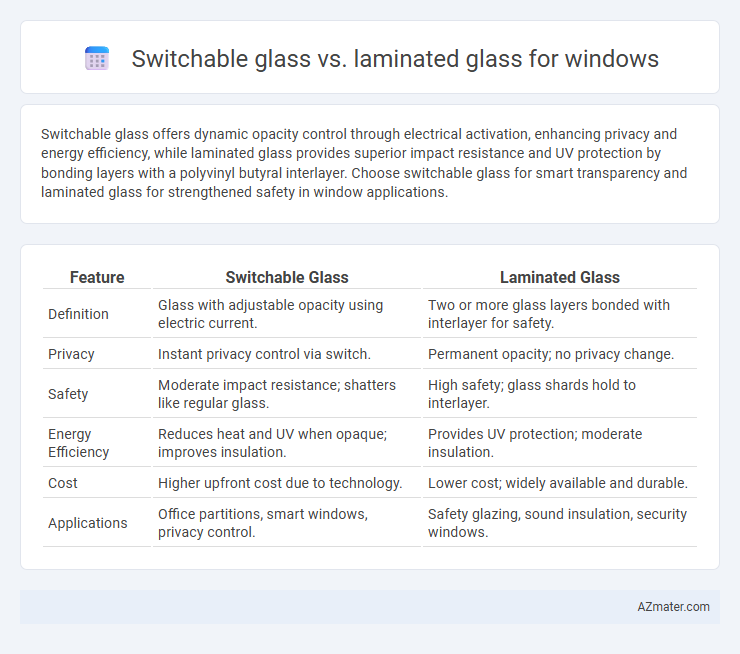Switchable glass offers dynamic opacity control through electrical activation, enhancing privacy and energy efficiency, while laminated glass provides superior impact resistance and UV protection by bonding layers with a polyvinyl butyral interlayer. Choose switchable glass for smart transparency and laminated glass for strengthened safety in window applications.
Table of Comparison
| Feature | Switchable Glass | Laminated Glass |
|---|---|---|
| Definition | Glass with adjustable opacity using electric current. | Two or more glass layers bonded with interlayer for safety. |
| Privacy | Instant privacy control via switch. | Permanent opacity; no privacy change. |
| Safety | Moderate impact resistance; shatters like regular glass. | High safety; glass shards hold to interlayer. |
| Energy Efficiency | Reduces heat and UV when opaque; improves insulation. | Provides UV protection; moderate insulation. |
| Cost | Higher upfront cost due to technology. | Lower cost; widely available and durable. |
| Applications | Office partitions, smart windows, privacy control. | Safety glazing, sound insulation, security windows. |
Introduction to Switchable Glass and Laminated Glass
Switchable glass, also known as smart glass, uses electrochromic technology to change from transparent to opaque with an electric current, offering privacy control and energy efficiency. Laminated glass consists of two or more glass layers bonded by an interlayer, providing enhanced safety, sound insulation, and UV protection. Both materials serve distinct purposes in window applications, with switchable glass focusing on dynamic light control and laminated glass prioritizing durability and security.
How Switchable Glass Works
Switchable glass, also known as smart glass, operates by applying an electric voltage to a special film embedded between glass layers, causing the glass to transition from opaque to transparent. This technology relies on liquid crystal or suspended particle devices that align when powered, controlling light transmission and privacy instantly. Unlike laminated glass, which uses a plastic interlayer for safety and soundproofing without altering transparency, switchable glass provides dynamic control over visibility and natural light.
How Laminated Glass Works
Laminated glass consists of two or more glass layers bonded together with an interlayer, usually made of polyvinyl butyral (PVB), which holds the glass layers in place when shattered, enhancing safety and security. This interlayer also reduces sound transmission and blocks harmful UV rays, contributing to energy efficiency and occupant comfort. Unlike switchable glass, which changes transparency with electrical input, laminated glass maintains a constant transparent state while providing impact resistance and durability for windows.
Key Differences Between Switchable and Laminated Glass
Switchable glass employs electrochromic or liquid crystal technology to change opacity with electrical current, offering privacy control and light modulation. Laminated glass consists of two or more layers of glass bonded with an interlayer, enhancing safety and sound insulation by holding shards together upon impact. Key differences include switchable glass's dynamic opacity feature versus laminated glass's static, impact-resistant structure.
Privacy and Light Control Comparison
Switchable glass offers instant privacy control by transitioning from transparent to opaque with the flip of a switch, allowing dynamic modulation of natural light without sacrificing views. Laminated glass enhances security and sound insulation while providing permanent privacy through embedded interlayers that restrict visibility but allow diffused light transmission. For adaptive privacy and light control in windows, switchable glass outperforms laminated glass by enabling customizable opacity levels and selective daylight management.
Safety and Security Features
Switchable glass offers privacy on demand and shatters into small, less dangerous pieces, enhancing safety by reducing injury risks upon impact. Laminated glass consists of multiple layers bonded with a strong interlayer, providing superior security by holding the glass together during breakage and deterring forced entry. Both types improve window safety, but laminated glass excels in impact resistance and burglary prevention while switchable glass adds functional privacy control.
Energy Efficiency and Insulation Benefits
Switchable glass offers dynamic control over light transmission, significantly reducing heat gain and enhancing energy efficiency by minimizing reliance on air conditioning and artificial lighting. Laminated glass provides superior insulation through its interlayer, effectively reducing heat transfer and improving soundproofing properties while maintaining safety and durability. Both technologies contribute to energy savings, with switchable glass excelling in adaptive solar control and laminated glass offering consistent thermal insulation.
Installation and Maintenance Considerations
Switchable glass requires professional electrical installation to integrate its smart technology, ensuring proper wiring and control system setup, while laminated glass installs like traditional glass with standard glazing techniques. Maintenance of switchable glass includes regular checks on electrical components and cleaning with non-abrasive materials to preserve functionality, whereas laminated glass demands minimal upkeep focused on inspecting seal integrity and surface damage. Installation time for switchable glass is typically longer due to complexity, while laminated glass offers quicker, cost-effective installation and simpler long-term maintenance.
Cost Analysis: Switchable vs Laminated Glass
Switchable glass typically costs between $50 to $120 per square foot, significantly higher than laminated glass, which ranges from $15 to $50 per square foot depending on thickness and brand. Installation and operational energy savings of switchable glass can offset its initial higher cost over time, making it a cost-effective choice for smart buildings. Laminated glass, while more affordable upfront, offers enhanced safety and noise reduction benefits but lacks the dynamic privacy and light control capabilities of switchable glass.
Best Applications for Switchable and Laminated Glass
Switchable glass is ideal for spaces requiring dynamic privacy control, such as conference rooms, healthcare facilities, and smart homes, where instant opacity adjustment enhances both functionality and aesthetics. Laminated glass excels in safety-critical applications including automotive windshields, skylights, and storefronts, offering superior impact resistance and shatter containment for enhanced security. Both glass types serve distinct purposes: switchable glass prioritizes adaptable transparency, while laminated glass emphasizes durability and protection in structural or high-risk environments.

Infographic: Switchable glass vs Laminated glass for Window
 azmater.com
azmater.com